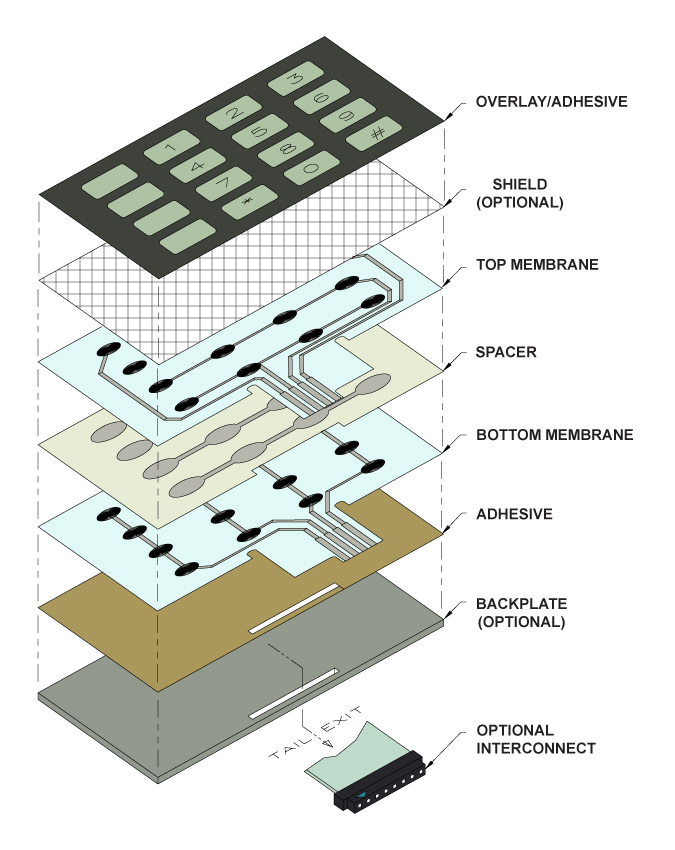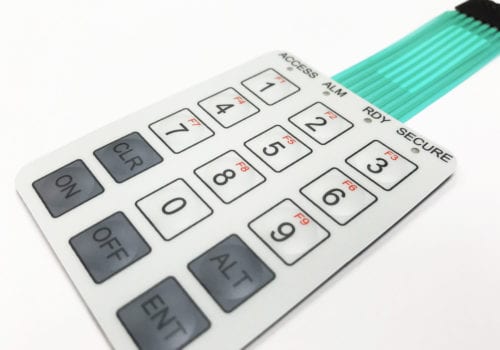Membrane Layer Switch Over Modern Technology: The Key to Trustworthy and Economical User Interfaces
Membrane layer switch modern technology has actually arised as an essential element in the design of individual interfaces, giving both dependability and cost-effectiveness across a diverse variety of applications. As we explore the complex advantages of membrane layer switches, their capacity for innovation elevates concerns regarding future applications and advancing trends.
Recognizing Membrane Change Technology
Membrane button technology is a commonly made use of user interface remedy in numerous electronic gadgets, supplying a smooth blend of performance and layout. This technology integrates multiple layers of materials, typically being composed of a graphic overlay, spacer layer, and a circuit layer. The visuals overlay displays the interface elements, while the spacer layer separates the circuit layer from the overlay till a customer turns on a switch.
When stress is put on the overlay, the circuit layer completes the electrical circuit, sending a signal to the device. This system permits different setups, consisting of responsive responses and backlighting alternatives, enhancing individual interaction. Membrane switches are commonly produced utilizing sturdy products such as polyester or polycarbonate, ensuring durability and resistance to ecological elements like wetness and dust.
The versatility of membrane switches enables their application in varied sectors, consisting of clinical tools, customer electronic devices, and industrial controls. Their portable layout permits integration into space-constrained atmospheres, offering a reliable interface without jeopardizing aesthetic charm. Understanding the details of membrane layer button innovation is crucial for makers and designers seeking to develop reputable and efficient human-machine interfaces.
Key Benefits of Membrane Buttons
While various interface services exist, membrane layer switches offer distinctive benefits that make them a favored option in various applications. Among the main benefits is their resilience; membrane buttons are created to endure harsh ecological problems, including dampness, dust, and temperature variations, making sure durable performance. This resilience significantly decreases the demand for regular replacements, therefore lowering overall upkeep prices.

Furthermore, membrane buttons are lightweight and compact, making them appropriate for applications where space is restricted. Their inconspicuous layout adds to a streamlined look without endangering performance.
Cost-effectiveness is additionally a notable advantage, as the manufacturing procedure for membrane switches tends to be cheaper compared to conventional mechanical switches. This cost, integrated with their integrity and convenience of installation, settings membrane changes as a useful remedy for a wide variety of industries looking for effective and efficient interface.
Applications Across Different Industries
How do membrane layer switches adjust to the varied requirements of numerous markets? Membrane switch modern technology is progressively recognized for its versatility, making it ideal for a broad array of applications throughout several sectors.
In customer electronics, membrane buttons give a portable solution for remote controls and home devices, enhancing customer experience via intuitive layout. In addition, the commercial sector leverages membrane buttons for equipment control panels, gaining from their resistance to extreme settings, such as dampness and dirt.
Army and aerospace applications also utilize membrane switches for their dependability and ability to endure severe problems, making sure operational efficiency in important situations. The food and drink sector adopts these switches for automated systems, where hygiene and ease of operation are paramount (membrane switch). Inevitably, membrane switches are customized to satisfy the special needs of each market, proving their important function in modern innovation user interfaces
Style and Modification Choices

In the realm of membrane layer see this here button modern technology, design and modification choices play an essential role in improving performance and individual communication. These switches can be customized to fulfill details operational needs and visual preferences, making them functional elements in various applications.
One of the key personalization options is the layout of the switch itself, which can be designed to suit one-of-a-kind interface and ergonomic considerations. By readjusting the form, size, and setup of buttons, manufacturers can produce instinctive styles that facilitate simplicity of next page usage. Additionally, the incorporation of various shades and visuals overlays allows for branding and boosted visibility, making certain that individuals can promptly identify features.
Furthermore, membrane layer buttons can be engineered with numerous responsive feedback systems, such as raised buttons or distinct clicks, to enhance the customer experience. Different products can additionally be selected for toughness and ecological resistance, dealing with variables such as wetness, temperature level changes, and chemical direct exposure.
Eventually, the considerable style and modification choices readily available in membrane layer button technology equip services to develop tailored options that not just satisfy useful demands however additionally align with their branding and operational requirements.

Future Trends in Membrane Layer Switches
As membrane switch modern technology remains to develop, future fads are significantly concentrated on enhancing user experience and incorporating advanced functionalities. One significant fad is the assimilation of touch-sensitive and capacitive technologies right into standard membrane layer buttons. This growth enables more intuitive interface, giving responsive feedback while maintaining a smooth layout.
An additional arising trend is making use of environmentally pleasant materials, driven by the expanding need for sustainable manufacturing practices. Makers are looking for to minimize their carbon footprint by using recyclable substrates and low-impact inks, lining up with global sustainability goals.
In addition, the increase of the Web of Things (IoT) is prompting the incorporation of clever attributes right read this article into membrane layer switches. Enhanced connectivity choices will certainly allow tools to connect with each various other, enabling seamless combination into broader systems.
In addition, advancements in printing innovations, such as digital printing, are permitting higher layout versatility and personalization. This enables suppliers to generate detailed styles and dynamic shades cost-effectively.

Final Thought
In verdict, membrane layer switch modern technology stands for an important innovation in individual interface layout, offering significant benefits in sturdiness, modification, and cost-effectiveness. As advancements proceed to arise, particularly in touch-sensitive interfaces and lasting products, the possibility for membrane layer switches over to improve individual experience and capability continues to be promising.
Comments on “The Evolution of Membrane Switch Technology in the Automotive Industry”